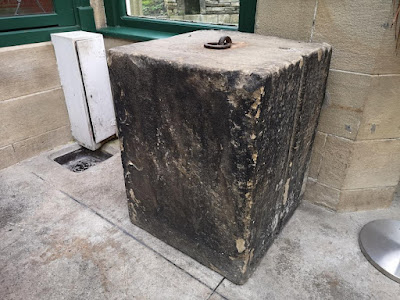 |
| Keighley Trader ....late 19th Century |
The 19th century was a time of great change for most people, none so more than some of our Bancroft ancestors who, as well as small-time farmers, managing a few acres of land, were also involved in the rapidly changing weaving and woolcombing occupation as this work moved from a cottage industry to the mill.
The pastures of the Yorkshire Dales have for centuries favoured dairy farming rather than that of arable, and until the 20th century farms were generally small, and the numbers of milk cows rarely ran into double figures. As all milking had to be done by hand, this was a time consuming daily job that today is handled efficiently by mechanical means to deal with the large dairy herds. The 19th century dairy farmers had their hands full dealing with the many tasks on the farm including dealing with the relatively small amounts of milk left over from their family’s use, as well as their other job producing wool products from their small cottages.
This demand was met by traders known as milk dealers, middlemen, who travelled to farms and villages and bought the spare products direct from the farmer, or at the markets, and then sold them to the retailer to use the raw milk to make butter and cheese.
Two Brothers, Michael and Mathew Bancroft, were both born in a cottage called “Hole House”, later known as “Hoyle House” in Oakworth near Keighley, from a family of fifteen children to Joseph Bancroft and his two wives Judith and Ellen [Nelly], and I wrote an article about this some time ago, which can be read HERE.
They were forced to move away from their textile work at home into milk trading, whilst they were employed on farms as labourers.
 |
| Hoyle House [Hole House] today |
Mathew Bancroft [1808-1891] who was shown as a “milk dealer” by the 1870’s. He married Mary Smith and together they had six children.
| 1871 census |
He married Mary Smith at Bingley Parish Church on 12/1/1835, and at that time was a woolcomber.
The occupation of a woolcomber was not an easy way to make a living as this was the period in the 1840-50 when new large woollen mills were springing up everywhere and the process of combing wool ready for weaving was largely dying out as a cottage industry.
To make matters worse for Mathew, who by then had a family of six children with his wife Mary to support, was unable to read and write as can be seen by the details on his father’s death certificate, where Mathew was the informant but had to just put his mark, an “x” rather than a signature.
 |
| Joseph Bancroft death certificate |
After the death of his wife Mary in 1870, he went to live with his daughter Martha Hartley and her family at Parker Street in Keighley, where census records show him as a “milk dealer”. He died there on 25/9/1891 and was buried together with other family members at Utley cemetery in Keighley.
Michael Bancroft [1805-1879] was shown on the 1866 marriage record of his son, Jabez, who was shown as a “milk dealer.”
 |
| Jabez Bancroft marriage certificate |
He married Ann Shackleton on 6/9/1829 at Bingley Parish Church and together they had eight children, and similarly to his brother Mathew, he spent his early working life as a weaver and then a woolcomber before getting involved in farming.
 |
| Michael & Ann marriage certificate |
Like his brother Mathew, Michael, was also illiterate, as can be seen on the marriage record shown below, and this fact must have made finding better employment more difficult for both of them, and probably lead to be taken advantage off them by would-be employers, which is probably why they could only get labouring work on farms in their later life.
Mathew and family followed the Methodist religion and were buried at Lees Wesleyan graveyard, where he was heavily involved and was a trustee
The two brothers turned to farm labouring around this time, as weaving and woolcombing became harder to make a living from, and it is probably that when they were working on farms, as labourers, that they saw the difficulties farmers were having getting rid of their spare milk production, so started buying the surplus milk from them and then selling it on to manufacturers for processing into butter and cheese which could then be stored until required.
Without the benefit of refrigeration, farmers had to preserve the milk by selling it to be turned into butter or cheese – and the production of both was a lengthy and time-consuming process.
As the populations of the industrial towns and villages expanded during the 19th century, milk, butter and cheese became an increasingly important agricultural commodity and the demand greatly increased. Butter and cheese production was big business in the late 19th century as, as people became more affluent.
The following two pictures of equipment of the time are below show.
 | ||
| Late 19th century churn advert |
 |
| Cheese weight |
No comments:
Post a Comment